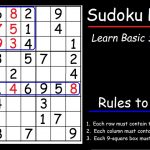Content Table:
Sudoku puzzles are brain teasers often referred to as wordless crossword puzzles. They require lateral thinking and have gained immense popularity worldwide, captivating players of all ages.
What is Sudoku?
Also known as Number Place, Sudoku puzzles are logic-based placement challenges. The objective is to fill a 9 x 9 grid with numbers from 1 to 9, ensuring that each digit appears exactly once in every row, column, and 3 x 3 subgrid. Some digits are provided as “givens,” and the challenge lies in using logic and deduction to fill in the remaining cells. Patience and strategic thinking are essential qualities for solving these intriguing puzzles.
The History of Sudoku
Number puzzles similar to Sudoku have existed for over a century and have featured prominently in various newspapers. One notable example is Le Si’cle, a French daily that, as early as 1892, published a 9 x 9 grid with 3 x 3 sub-squares, using double-digit numbers instead of the current 1-9. Another French publication, La France, created a puzzle in 1895 that utilized the numbers 1-9 but lacked the 3 x 3 sub-squares, yet the solution still contained the digits 1-9 in each of the corresponding regions. These early puzzles were regular features in various newspapers, including L’Echo de Paris, until they disappeared with the onset of World War I.
The Modern Sudoku
Howard Garns, a 74-year-old retired architect and freelance puzzle constructor, is credited as the designer of modern Sudoku puzzles. His creation was first published in 1979 by Dell in New York through its magazine Dell Pencil Puzzles and Word Games, under the title “Number Place.” Garns’ design was likely inspired by the Latin square concept introduced by mathematician Leonhard Euler, enhanced with a regional restriction and a partially completed grid, requiring solvers to fill in the empty cells.
Sudoku’s Rise in Japan
Sudoku puzzles made their way to Japan through the puzzle publishing company Nikoli, which introduced the game in its publication Monthly Nikoli in April 1984. Maki Kaji, the president of Nikoli, named the game “Sudoku,” a title that the company holds trademark rights over. Other Japanese publications that wanted to feature the puzzle had to resort to alternative names.
Sudoku in Video Games
In 1989, Sudoku puzzles entered the realm of video games with the release of DigitHunt on the Commodore 64, published by Loadstar/Softdisk Publishing. Since then, numerous computerized versions of Sudoku have been developed. For instance, in 1995, Yoshimitsu Kanai created several computerized puzzle generators for the Apple Macintosh under the name “Single Number,” available in both English and Japanese. Subsequent versions appeared for the Palm PDA in 1996 and for Mac OS X in 2005.
The Appeal of Sudoku
Sudoku’s popularity continues to grow, attracting players looking for a stimulating and enjoyable challenge. The combination of logic, strategy, and the satisfaction of solving puzzles makes Sudoku a favorite pastime for many. Whether you prefer to play on paper, on your computer, or through a mobile app, Sudoku offers a brain-teasing experience that can be enjoyed anytime, anywhere.
Conclusion
In summary, Sudoku puzzles have evolved from their historical roots to become a global phenomenon in gaming. They challenge our minds, enhance our problem-solving skills, and provide countless hours of entertainment. As you embark on your Sudoku journey, remember that every puzzle is an opportunity to engage your brain and enjoy the thrill of logical deduction.



